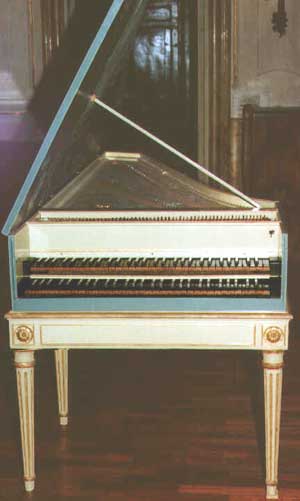
Clavicembalo Jean Henri Hemsch, 1756, copia di Augusto Bonza, 1988
Il clavicembalo usato per la registrazione è la copia di uno strumento di Jean Henri Hemsch costruita nel 1988 dal mastro cembalaro Augusto Bonza. Il cembalo è stato realizzato nel rispetto dei procedimenti costruttivi del passato, seguendo i più rigorosi criteri d’esecuzione di una copia, dove lavorazione manuale e competenza tecnica sono il fondamento di quell’ impianto operativo che è premessa d’ogni strumento musicale degno di apprezzamento. Lo strumento ha due manuali di cinque ottave e possiede tre registri, due di otto piedi il terzo all’ottava. I materiali utilizzati nella costruzione sono i legni consueti della tradizione parigina del XVIII secolo: tiglio per la cassa e le tastiere – rivestite d’ebano e avorio – abete rosso per la tavola armonica, quercia per il somiere. L’accurato lavoro di riproduzione dell’originale ha consentito di restituire la sensibilità e la qualità timbrica dei clavicembali di Hemsch, noto tra i cembalari parigini del secolo XVIII per l’eccellenza delle sue opere. Jean Henri Hemsch nacque a Castenholz vicino a Colonia, il 21 Febbraio 1700. Emigrato a Parigi intorno al 1720, fu ben presto ammesso alla corporazione dei costruttori di clavicembali, e sebbene straniero fu eletto alla giuria della corporazione nel 1746. Nel 1767, Henri, che non si sposò mai, fece testamento. Dopo la sua morte, l ‘intera attività fu lasciata al nipote Jean Henri Moers che era stato a capo del suo laboratorio per più di 15 anni.
Harpsichord by Jean Henri Hemsch, 1756, copy by Augusto Bonza, 1988
The harpsichord used for this recording is a copy of an instrument by Jean Henri Hemsch, and was built in 1988 by the harpsichord maker Augusto Bonza. The instrument has been built in a way that respects the methods of construction used in the past, following the most rigorous criteria appropriate for making a copy, for which competence in handicraft and technique is fundamental and a basic requirement for every musical instrument which merits appreciation.
The instrument has two manuals of five octaves and three registers (two 8’and one 4′). The materials used in the construction are the woods traditionally used in the 18 th century in Paris: lime for the case and keys – with ebony and ivory covering – spruce for the soundboard and oak for the wrestplank.
The accuracy of the work used to reproduce the original has enabled a ret rn to the characteristic touch and timbre of harpsichords by Hemsch, who was famous among 18 th century builders in Paris for the excellence of his work. Jean Henri Hemsch was born in Castenholz, near Köln, on the 21 st February 1700. He moved to Paris around 1720, where he was soon admitted to the Guild of Harpsichord Makers, and , although a foreigner, was elected to the guild jury in 1746. In 1767 Henri, who had never married, made his will. After his death in 1769 the business was taken over by his nephew Jean Henri Moers, who had already been directing the workshop for more than 15 years.